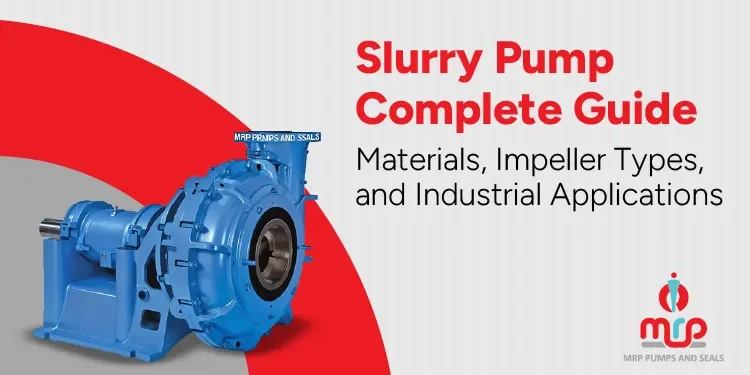Introduction
Slurry pumps handle some of the most challenging fluid transfer tasks in industrial operations, moving abrasive mixtures of solids and liquids that would destroy conventional pumps in days. For chemical, pharmaceutical, and process industry professionals, selecting the right slurry pump with appropriate materials and impeller design can mean the difference between continuous operation and costly downtime.
At MRP Pumps, we’ve seen how the wrong pump selection can affect production schedules and maintenance budgets. This complete guide breaks down everything you need to know about slurry pump materials, impeller types, and applications to help you make informed decisions about your critical processes.
What is a Slurry Pump?
A slurry pump is a specialized centrifugal pump designed to handle mixtures containing solid particles suspended in liquids. With different standard liquid pumps, these accurate machines can transport everything from fine sand particles to large parcels of metal without clogging or excessive wear.
The key difference will be in their construction. Slurry pumps feature larger clearances, reinforced casings, and wear-resistant components that can withstand the abrasive action of suspended solids. They typically handle particle concentrations from 1% to 70% by weight, depending on the application.
Most slurry pumps operate on centrifugal principles, using an impeller to create velocity that converts to pressure head. However, their design modifications allow them to maintain efficiency even when handling highly abrasive or corrosive slurries that would quickly damage conventional centrifugal process pumps.
Why Do Slurry Pump Materials Matter More Than You Think?
Choosing the right material for your slurry pump isn’t just a technical decision — it impacts performance, safety, and long-term costs. A poor choice can lead to early failure, leaks, and expensive downtime.
- Corrosion Resistance:
If you’re dealing with acidic or caustic slurries, corrosion resistance is key.
For example, chemical plants using sulfuric acid need different pump materials than mines handling neutral slurries. The material must withstand both chemical attack and physical wear.
- Abrasion Resistance:
The hardness, size, and shape of particles matter.
Sharp quartz particles wear down pumps faster than smooth sand grains. Depending on your slurry, you might need high-chrome iron, rubber linings, or advanced polymers for better protection.
- Temperature Stability:
High temperatures can weaken some materials or make plastics too soft.
If your slurry is hot, choose materials that stay strong and durable under heat stress.
What Are the Main Types of Slurry Pump Impellers?
1. Open Impellers
Open impellers lack front and rear protection, featuring only blades attached to the hub. This design provides excellent passage for large particles and tough materials while allowing easy inspection and cleaning.
The downside is lower efficiency compared to enclosed designs, typically 5-15% less efficient due to internal circulation losses. However, for heavily loaded slurries or applications with large objects, the clog-free operation often outweighs efficiency concerns.
2. Semi-Open Impellers
Semi-open impellers include a back shroud but leave the front open. This design offers better efficiency than open impellers while maintaining good passage capabilities for moderately abrasive slurries.
They’re ideal for applications requiring a balance between efficiency and solids handling capability. The back shroud provides structural support and reduces internal losses while the open front allows for particle passage.
3. Closed Impellers
Fully enclosed impellers with front and rear shrouds deliver the highest efficiency, often 10-20% better than open designs. However, they’re susceptible to clogging with large particles or flexible materials.
These work best with fine slurries where particle size is consistently small and uniform. Chemical processing applications with deposits or crystalline suspensions often benefit from closed impeller designs.
4. Vortex Impellers
Vortex impellers create a vibrating action that moves solids without direct contact. The impeller operates in a low chamber, creating a vortex that entrains and moves particles through centrifugal force.
This design minimizes particle degradation and reduces wear on both the impeller and the solids being pumped. It’s particularly valuable for applications where maintaining particle integrity is important.
Which Industries Depends Most on Slurry Pumps?
1. Mining and Mineral Processing
Mining operations generate massive volumes of slurry from ore processing, tailings disposal, and mineral concentration. These applications typically involve high-volume, continuous operation with unique particle sizes and concentrations.
Copper, iron ore, and coal processing facilities depend on slurry pumps for flotation circuits, thickener underflows, and material transport. The abrasive nature of mineral particles demands effective construction and strategic material selection.
2. Chemical and Pharmaceutical Manufacturing
Chemical plants use slurry pumps for catalyst handling, solid transfer, and waste processing. PVDF pumps and polypropylene pumps are ideal in corrosive environments where metal pumps fail quickly.
Pharmaceutical facilities require sanitary designs with easy cleaning capabilities. Magnetic drive pumps eliminate seal leakage concerns, critical for containing expensive or hazardous pharmaceutical intermediates.
3. Wastewater Treatment
Municipal and industrial wastewater treatment facilities depend on slurry pumps for sludge handling, grit removal, and thickener operations. These applications combine abrasive solids with potentially corrosive liquids.
The changing nature of wastewater composition requires flexible pump designs that can handle unexpected particles while maintaining reliable operation for critical infrastructure.
4. Power Generation
Coal-fired power plants use slurry pumps for ash handling, limestone slurry preparation, and flue gas elimination systems. These high-temperature, abrasive applications demand specialized materials and effective construction.
Nuclear facilities employ slurry pumps for chemical waste processing, requiring containment systems that prevent any environmental pollution.
How Do You Choose the Right Slurry Pump Material?
1. Metal Options: Strength and Versatility
- High-chromium iron:
Offers excellent abrasion resistance for neutral pH applications. With 15-28% chromium content, these alloys resist wear while maintaining reasonable cost. They’re ideal for mining and aggregate applications where corrosion isn’t a primary concern. - Stainless steel:
Provides corrosion resistance for mildly acidic or caustic slurries. Grades like 316L offer good chemical compatibility, though they may wear faster than metallic alternatives in highly abrasive service. - Duplex stainless steels:
Combine strength and corrosion resistance, offering superior performance in aggressive chemical environments. However, their higher cost limits use to critical applications where standard materials fail swiftly.
2. Elastomer Linings: Flexibility and Impact Resistance
- Natural rubber:
Provides excellent abrasion resistance and impact absorption for neutral pH slurries. It’s particularly effective with angular particles that would quickly wear metal surfaces. - Polyurethane:
Offers superior cut and tear resistance compared to rubber, making it ideal for applications with sharp particles or high velocities. It maintains flexibility while providing excellent wear life. - EPDM and Viton:
Elastomers handle chemical compatibility requirements while providing reasonable abrasion resistance. They’re valuable for applications where both chemical attack and particle wear are concerns.
3. Polymer Solutions: Chemical Resistance Champions
- PVDF (Polyvinylidene Fluoride):
Excels in highly corrosive environments, offering broad chemical compatibility and good mechanical properties. PVDF pump suppliers like MRP Pumps provide these solutions for aggressive chemical processing applications. - Polypropylene:
Offers cost-effective corrosion resistance for many chemical applications. While not as powerful as PVDF, it provides adequate performance for less demanding chemical transfer operations. - PEEK and other high-performance polymers:
Handle extreme chemical and temperature conditions but come with higher material costs that limit their use to specialized applications.
What Performance Factors Should You Consider?
1. Efficiency and Energy Consumption
Slurry pumps typically operate at lower speeds than clear liquid pumps due to internal losses from solids circulation and impeller design compromises. Understanding this helps set realistic expectations and calculate true operating costs.
Impeller design significantly impacts efficiency. Closed impellers achieve 65-75% efficiency with fine slurries, while open impellers may reach only 45-60% with the same fluid. However, efficiency must be balanced against reliability and maintenance requirements.
System head losses increase with slurry concentration and particle size. Pipeline friction factors can double, or triple compared to clear water, requiring careful system design to avoid pump operation far from its best efficiency point.
2. Wear Life and Maintenance
Predictive maintenance becomes especially important for slurry pump operations. Vibration monitoring, power consumption tracking, and flow rate measurement help identify wear patterns before sudden failure.
Component wear rates differ dramatically with application conditions. Impellers may require replacement every 3-6 months in severe duty while lasting 2-3 years in moderate service. Understanding these patterns helps optimize maintenance scheduling.
Spare parts strategy should consider lead times and value. Keeping complete pump assemblies for critical applications may be more cost-effective than risking extended downtime waiting for parts.
Material Comparison Table: Choosing the Right Option
| Material Type | Abrasion Resistance | Corrosion Resistance | Cost | Best Applications |
| High-Chromium Iron | Excellent | Poor-Fair | Low | Mining, neutral pH slurries |
| Stainless Steel 316L | Good | Excellent | Medium | Chemical processing, food grade |
| Natural Rubber Lined | Excellent | Fair | Low-Medium | Coal preparation, aggregate |
| Polyurethane Lined | Excellent | Good | Medium | Sharp particles, high velocity |
| PVDF | Fair-Good | Excellent | High | Acid handling, pharmaceutical |
| Polypropylene | Fair | Very Good | Low-Medium | General chemical transfer |
What’s New in Slurry Pump Technology?
- Digital monitoring: Integration allows real-time performance tracking and predictive maintenance scheduling. Smart sensors monitor vibration, temperature, and flow parameters to optimize operation and prevent failures.
- Advanced materials: Development continues improving both wear and corrosion resistance. Nanocomposite coatings and hybrid metal-polymer designs promise longer service life in extreme applications.
- Energy efficiency: Improvements focus on impeller design optimization and variable speed drive integration. New analytical fluid dynamics tools enable a better understanding of slurry flow patterns and pump performance.
- Modular designs: Simplify maintenance and reduce inventory requirements. Standardized interfaces and component flexibility help minimize downtime and spare parts complexity.
How Can MRP Pumps Help Your Operation?
Selecting the optimal slurry pump requires understanding of your specific application conditions, performance requirements, and maintenance capabilities. MRP Pumps specializes in corrosion-resistant and leak-proof pumping solutions for the chemical, pharmaceutical, and process industries.
Our magnetic drive pump technology eliminates seal leakage concerns while our acid transfer pump designs handle the most aggressive chemical environments. Whether you need polypropylene pumps for general chemical service or specialized PVDF pumps for extreme conditions, we provide engineered solutions that maximize uptime and minimize total cost of ownership.
Ready to optimize your slurry pumping operations? Contact MRP Pumps today for expert consultation on material selection, pump sizing, and application engineering. Our team helps you choose the right solution for maximum performance and reliability. Visit mrppumps.com to explore our complete range of industrial pumping solutions.




